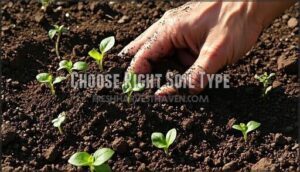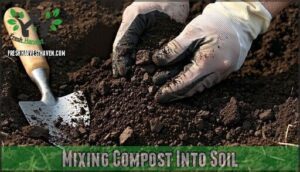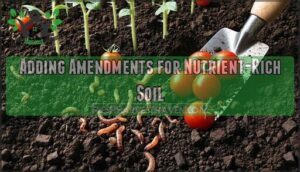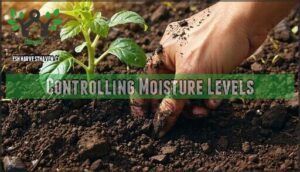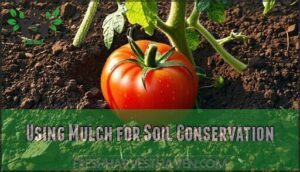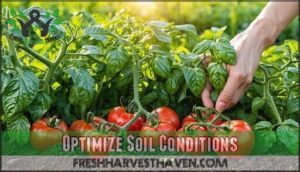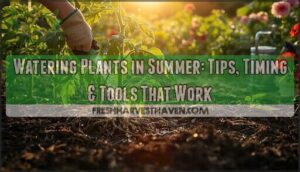This site is supported by our readers. We may earn a commission, at no cost to you, if you purchase through links.
 You’ll dramatically improve soil for growing tomatoes by mixing in 2-3 inches of compost or aged manure to boost nutrients and drainage.
You’ll dramatically improve soil for growing tomatoes by mixing in 2-3 inches of compost or aged manure to boost nutrients and drainage.
Test your soil’s pH and adjust it to 6.0-6.8 using lime for acidic soil or sulfur for alkaline conditions.
Heavy clay needs perlite or coarse sand to prevent waterlogging, while sandy soil benefits from organic matter that retains moisture.
Work these amendments 8-10 inches deep before planting.
Your tomatoes need soil that drains well but holds enough water and nutrients to fuel their growth. The secret lies in understanding which specific amendments work best for your particular soil type.
Table Of Contents
Key Takeaways
- Mix 2-3 inches of compost or aged manure into your soil and work it 8-10 inches deep to boost nutrients and improve drainage for healthier tomato plants.
- Test your soil’s pH and adjust it to the ideal range of 6.0-6.8 using lime for acidic soil or sulfur for alkaline conditions to maximize nutrient absorption.
- Choose well-draining loam to sandy loam soil and avoid heavy clay that compacts and traps water around roots, which can cause root rot and stunted growth.
- Apply 2 inches of organic mulch around your plants to retain moisture, regulate soil temperature, and gradually add nutrients as it decomposes throughout the growing season.
Improve Soil Quality
You’ll transform ordinary dirt into tomato gold by focusing on three essential elements: organic matter, pH balance, and proper drainage.
Start by testing your soil’s current condition, then add compost to boost nutrients, adjust pH to the sweet spot of 6.2-6.8, and improve drainage to prevent waterlogged roots that kill plants, which is crucial for the proper drainage.
Adding Organic Matter
Compost benefits your tomato plants by feeding soil organisms that create nutrient-rich environments.
Mix aged manure options like cow or chicken into your garden beds each spring. Worm castings work as premium soil amendments for tomatoes, while green manures from cover crops naturally boost soil composition.
Mycorrhizal fungi can enhance nutrient absorption. Layer organic matter two inches deep, then work it into the top six inches of soil to create a healthy environment.
Adjusting PH Levels
You’ll need to test your soil pH levels first—tomatoes thrive in the ideal range of 6.0 to 6.8.
If your soil’s too acidic, apply garden lime gradually. For alkaline soil tomatoes struggle in, use elemental sulfur to lower pH.
Testing frequency should be annual since soil acidity fluctuates. Proper soil pH tomatoes need guarantees better nutrient absorption and healthier plants.
A balanced pH is vital because it directly affects nutrient availability.
Enhancing Drainage
Poor drainage turns your tomato dreams into soggy nightmares.
Clay soil fix starts with adding sand, perlite, or compost incorporation to break up compacted earth.
Raised beds and container drainage offer foolproof solutions for stubborn soil.
Create well-drained soil by improving soil texture through organic amendments.
Proper mulch management prevents waterlogging while maintaining ideal soil drainage for thriving plants.
Choose Right Soil Type
Your tomato plants won’t reach their full potential if you’re working with the wrong soil foundation.
Poor soil foundation means poor tomato harvest—get the basics right first.
You’ll need well-draining loam to sandy loam soil with a slightly acidic pH between 6.0 and 6.8 to create the ideal growing environment for maximum fruit production.
Loam to Sandy Loam Soil
Your tomatoes thrive best in loam to sandy loam soil that strikes the perfect balance between drainage and moisture retention.
This Ideal Soil Texture supports healthy Root Development while ensuring ideal Nutrient Availability.
Key benefits of this tomato soil mix include:
- Excellent drainage prevents waterlogged roots
- Retains enough moisture for consistent growth
- Allows easy root penetration and expansion
- Provides balanced Soil Composition for nutrients
Avoiding Heavy Clay Soil
Clay soil creates a nightmare for tomato roots.
Heavy clay compacts tightly, blocking oxygen and trapping water around roots. This soil compaction prevents proper root development and causes drainage problems.
You’ll face stunted plants and potential root rot. Amending garden soil with organic matter helps, but clay soil problems require serious intervention.
Choose well-drained soil alternatives like raised beds or containers instead. To overcome this, consider methods to improve clay soil drainage.
Slightly Acidic PH Range
Your tomato plants crave that sweet spot between 6.0 and 6.8 on the pH scale.
This ideal pH range facilitates maximum nutrient availability, letting roots absorb essential minerals efficiently.
Use a soil pH tester to check your levels.
If you’re dealing with acidic soil, add lime to raise pH. For alkaline conditions, incorporate sulfur for proper pH balancing and healthier growth.
Top 5 Soil Options
You’ll find dozens of soil options at your local garden center, but not all mixes provide the ideal drainage, nutrients, and pH balance tomatoes need to thrive.
These five carefully selected soil products offer proven performance for container and raised bed tomato growing, with each mix formulated to support healthy root development and maximum fruit production.
1. FoxFarm Ocean Forest Potting Soil
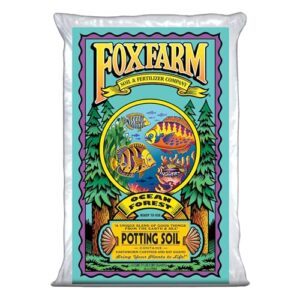
When you’re looking for premium soil that’ll make your tomatoes thrive, FoxFarm Ocean Forest stands out from the crowd.
This nutrient-rich blend combines aged forest products with sphagnum peat moss and perlite for excellent drainage. You’ll get earthworm castings, bat guano, and fish emulsion that feed your plants naturally.
The pH sits perfectly between 6.3-6.8, eliminating guesswork. While it costs more than basic mixes, the results speak for themselves, with your tomato plants developing stronger root systems and producing bigger harvests in this premium growing medium.
Best For: Gardeners who want a premium, organic soil mix that boosts plant growth and is especially effective for tomatoes, vegetables, or prized houseplants.
- Organic, nutrient-rich blend supports vigorous plant growth and high yields
- Balanced pH (6.3–6.8) removes pH guesswork and increases fertilizer effectiveness
- Excellent water retention and drainage reduces risk of root rot
- More expensive than standard potting soil
- High water retention can make overwatering more likely if not monitored
- Requires adequate pot filling to prevent nutrient deficiencies
2. Miracle-Gro Organic Container Mix 2-Pack

Finding the perfect balance between organic nutrition and container convenience makes this 2-pack a solid choice for tomato growers.
You’ll get continuous feeding for three months from the aged compost blend, while the OMRI certification guarantees you’re meeting organic standards.
The lightweight texture promotes excellent drainage and root development in containers. However, you might need to water more frequently due to the quick-draining properties.
Some gardeners report soil settling issues, so consider buying extra bags. The organic ingredients deliver reliable results without synthetic chemicals, providing a reliable and continuous feeding solution.
Best For: Organic gardeners who want a convenient, OMRI-certified container mix for vegetables, herbs, and flowers.
- Soil settles, often requiring additional bags to top off containers.
- Needs more frequent watering due to quick drainage.
- Inconsistent quality between bags, with occasional large wood pieces.
- Provides up to 3 months of continuous organic nutrition.
- Lightweight blend supports strong drainage and root growth.
- Certified organic and free from synthetic chemicals.
3. Sun Gro Black Gold Potting Soil
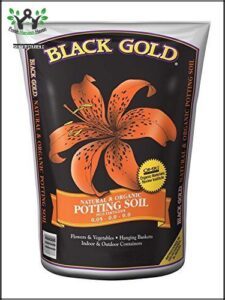
When organic certification matters most, Sun Gro Black Gold delivers OMRI-approved quality that serious gardeners trust.
This premium potting soil combines rich loam with Canadian sphagnum peat moss, creating the perfect foundation for your tomato plants.
You’ll appreciate the added perlite and pumice that provide excellent drainage while maintaining moisture retention.
The screened earthworm castings and forest humus boost soil fertility naturally, making it ideal for containers and raised beds where soil quality control is essential, and it’s regionally formulated for consistent performance.
Best For: Gardeners seeking high-quality, organic potting soil for tomatoes, vegetables, and herbs in containers or raised beds, especially in the Western region.
- Regional formulation may limit availability and consistency in other areas
- May require extra fertilizer or amendments for some plants
- Some users note variations in composition and lack of loam
- OMRI-listed for certified organic gardening
- Excellent drainage and moisture retention from perlite and pumice
- Natural additives like earthworm castings and forest humus boost fertility
4. Espoma Organic Potting Soil Mix

Gardeners consistently praise Espoma’s organic potting mix for its nutrient-rich composition and excellent drainage properties.
You’ll find this blend contains 35-45% sphagnum peat moss, earthworm castings, and myco-tone—a specialized blend of mycorrhizae that enhances root development.
The mix works exceptionally well for container tomatoes, providing ideal moisture retention without waterlogging.
For superior nutrient availability, maintain a soil pH of 6.0-7.0.
While some users report occasional pest issues due to its living soil nature, most find it delivers robust plant growth when properly managed and stored correctly.
Best For: Organic gardeners and container plant enthusiasts seeking nutrient-rich, all-natural soil for vegetables, herbs, and flowers.
- Quality can be inconsistent across different batches, with occasional pest or mold issues
- Prone to dryness, often requiring extra watering upon use
- Price may fluctuate and can be considered high, especially online
- Rich in natural ingredients like peat moss, earthworm castings, and mycorrhizae for strong root growth
- Delivers excellent drainage and moisture retention, ideal for container gardening
- Widely recommended by experts for robust plant health and organic practices
5. FLORAL Potting Soil for Vegetables Herbs
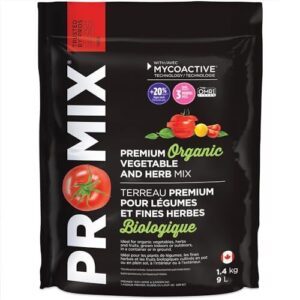
FLORAL Potting Soil delivers a specialized blend that’s engineered specifically for vegetables and herbs.
You’ll appreciate its pH-balanced formula that maintains the slightly acidic to neutral range (6.0-7.0) tomatoes crave.
The lightweight composition includes perlite and vermiculite for excellent drainage while retaining consistent moisture, and premium organic compost enriches the mix with slow-release nutrients that feed your plants throughout the growing season.
This soil prevents waterlogging and supports beneficial bacterial growth, making it ideal for containers and raised beds where drainage control matters most.
Best For: Home gardeners and urban growers looking for a specialized, pH-balanced soil mix designed for vegetables and herbs in containers or raised beds.
- May need additional nutrients for heavy-feeding plants late in season
- Not suited for acid-loving plants outside the 6.0-7.0 pH range
- Pricier than basic garden soil mixes
- PH-balanced formula ideal for most vegetables and herbs
- Lightweight blend with good drainage and moisture retention
- Slow-release organic nutrients support plant health all season
Prepare Soil for Tomatoes
You’ll need to create the perfect growing environment by mixing a 2-inch layer of compost into the top 6 inches of your garden soil each spring.
This preparation guarantees your tomatoes get the nutrient-rich, well-draining foundation they need while maintaining the slightly acidic pH between 6.2 and 6.8 that promotes ideal growth, with a focus on a slightly acidic environment.
Mixing Compost Into Soil
When spring arrives, you’ll want to mix a 2-inch layer of compost into your tomato bed’s top 6 inches of soil.
This organic matter improves soil structure while providing essential nutrients through gradual compost decomposition stages.
The compost application rate guarantees proper compost nutrient availability without overwhelming plants.
Well-aged compost creates the foundation for successful soil preparation tomatoes need, ensuring proper nutrient availability.
Adding Amendments for Nutrient-Rich Soil
Beyond compost application, you’ll need targeted soil amendments tomatoes for nutrient-rich soil.
Soil testing reveals what your tomato fertilizer strategy should include.
Address nutrient deficiencies through these soil preparation tomatoes essentials:
- Manure benefits include slow-release nitrogen and improved soil composition tomatoes
- Bone meal provides phosphorus for strong root development
- Epsom salts correct magnesium deficiency in sandy soils
- pH adjustment using lime or sulfur optimizes nutrient uptake
Consider buying manure products for superior results to ensure your tomatoes receive the necessary nutrients for healthy growth, including the use of bone meal and proper pH adjustment.
Controlling Moisture Levels
Moisture balance makes or breaks tomato success.
Soil success starts with balance—get moisture right, and your tomatoes will reward you with incredible harvests.
Check soil saturation by inserting your finger two inches deep—it should feel like a wrung-out sponge**.
Install drainage solutions if water pools after rain.
Apply mulch benefits around plants to boost soil moisture retention while preventing soil compaction.
Well-drained soil with proper soil aeration prevents deadly root rot that kills plants overnight.
Maintain Soil Health
You can’t just plant tomatoes and forget about your soil’s long-term health if you want consistent, productive harvests year after year.
Maintaining soil health requires strategic crop rotation, regular monitoring for pest and disease issues, and applying organic mulch to conserve moisture and nutrients throughout the growing season, which is crucial for consistent harvests.
Crop Rotation and Soil Reuse
Rotating crops breaks the disease cycle that plagues tomato growers year after year.
You can’t just plant tomatoes in the same spot forever—nightshade avoidance requires strategic planning.
Here’s your three-year cycle approach:
- Year one: Plant tomatoes with compost replenishment
- Year two: Grow legumes for soil restoration
- Year three: Add cover crops before replanting adjustments
This rotation delivers proven disease prevention benefits.
Monitoring for Pests and Diseases
Watching your tomato plants closely helps catch problems before they destroy your harvest.
Regular inspections of leaves, stems, and soil reveal early signs of aphids, hornworms, or fungal diseases.
Check for yellowing leaves, holes, or unusual spots weekly.
Healthy tomato soil naturally supports disease suppression, while organic controls like neem oil protect plants without harsh chemicals.
Attracting beneficial insects like ladybugs can assist with natural aphid control, which is a form of natural control and helps with organic gardening.
Using Mulch for Soil Conservation
Organic mulch transforms your tomato soil health by creating a protective barrier that retains moisture and suppresses weeds.
Apply a 2-inch layer of shredded bark or compost around plants after soil warms in spring. This mulch regulates soil temperature while slowly decomposing to add nutrients.
Consider organic options for mulch to improve your soil. Choose materials with slower decomposition rates for season-long soil preparation benefits, using organic methods to enhance soil health and mulch effectiveness.
Optimize Soil Conditions
You can maximize your tomato harvest by fine-tuning soil conditions through strategic placement, temperature control, and natural enhancements.
Raised beds warm faster in spring and provide better drainage, while cover crops like winter rye improve soil structure and add essential nutrients for the next growing season, which can help you maximize your tomato harvest by using natural enhancements.
Considering Raised Beds and Containers
Raised beds and containers offer perfect alternatives when you’re dealing with poor native soil conditions.
Container soil depth needs at least 12 inches for healthy root development, while raised bed filling requires 15-18 inches of quality potting mix.
Limited space gardening becomes manageable with precise soil control, letting you create ideal well-drained soil conditions for tomato soil improvement.
The best results come from using well-draining loamy soil, which is essential for healthy root development and quality potting mix, and ultimately leads to a successful tomato soil improvement.
Managing Soil Temperature and Moisture
You’ll want to monitor soil temperature and moisture levels regularly for ideal tomato growth.
Deep watering techniques encourage strong root development while preventing water stress. Apply organic mulch for soil insulation and moisture retention benefits.
Check soil moisture by inserting your finger two inches deep.
Proper drainage solutions prevent waterlogging, and consistent watering schedules maintain healthy plants, which is crucial for strong root development and overall healthy plants.
Using Cover Crops for Soil Enhancement
Cover crops transform your tomato soil between growing seasons.
Plant winter rye or hairy vetch for nitrogen fixation and erosion control.
These green manure crops add organic matter while providing weed suppression.
Legumes boost soil nitrogen by up to 150 kg per hectare.
Till cover crops into soil before planting tomatoes to improve soil structure and enhance long-term soil health through natural crop rotation.
Frequently Asked Questions (FAQs)
How often should I test my soil?
Test your soil annually before planting season to monitor pH and nutrient levels.
If you’ve added amendments or experienced plant problems, retest mid-season.
New gardens benefit from testing twice yearly initially.
Can coffee grounds improve tomato soil quality?
Coffee grounds make up 30% of household waste.
You can use them to slightly acidify your tomato soil, but don’t overdo it—they’re low in nutrients and high acidity can harm plants if used excessively.
Whats the best soil depth for tomatoes?
You’ll need at least 12 inches of soil depth for containers and 15-18 inches for raised beds.
Tomato roots spread wide and deep, so deeper soil means healthier plants and bigger harvests.
Should I sterilize reused container soil first?
Yes, you should sterilize reused container soil to eliminate harmful pathogens and pests. Bake moistened soil at 180°F for 30 minutes, or pour boiling water over it and let cool completely.
How do I fix compacted garden soil?
Ironically, that rock-hard soil you’re cursing actually wants to breathe. Break up compacted earth by adding compost, working in coarse sand, and double-digging beds. Your garden’s crying for oxygen underneath.
Conclusion
Perfect preparation pays off when you improve soil for growing tomatoes with these proven methods.
You’ve learned how proper pH levels, organic amendments, and drainage create the foundation for healthier plants and bigger harvests.
Remember that soil improvement isn’t a one-time task—it’s an ongoing process that rewards your efforts season after season.
Start with soil testing, add your chosen amendments, and watch your tomato plants thrive in their nutrient-rich environment this growing season.
- https://agritech.fnb.tech/tomato-growth-optimization-essential-strategies/
- https://thescientificgardener.com/soil-conditions-growing-tomato-plants
- https://gardening.cals.cornell.edu/garden-guidance/foodgarden/vegetable-growing-guides/tomato-growing-guide/
- https://www.rhs.org.uk/vegetables/tomatoes/grow-your-own
- https://www.mdpi.com/2073-4395/14/5/966


